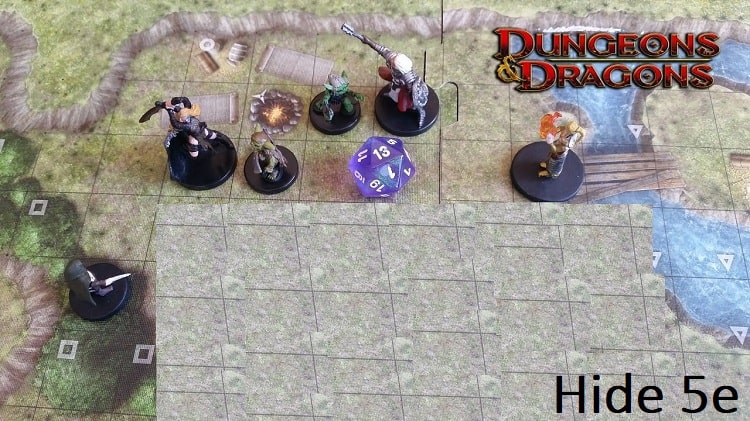Hide 5e | How Hide Action Dnd Work In 5e – Guide (2023)
The hide 5e is a simple action. Visitors may be using your path to take the Hide action 5e during your round. You’ll be requested to create a Dexterity (Stealth) test. If you pass this test, you’ll enjoy the advantages of becoming an invisible attack.
Table of Contents
What do you mean by the Hide action 5e?
The significance of posture and field management in DnD 5e hide combat is a common theme I’ve recently emphasized. In battle, possessing a favorable location might mean the difference between success and loss. Anybody in 5e could use Hide action as their tool to help you assume such posture in combat.
However, the Hide action 5e is often used in battle to make a Dexterity test. If the hero passes this test, they will gain the invisible fighter reputation, both offensively and defensively.
Hence due to its large act economic price, most characters will not employ the dnd Hide frequently. Nevertheless, a few lessons can often use the hidden assailant concept, but we’ll get to that soon.

D&D 5e hide action how you use the Hide action 5e?
I’ll set out almost all of the rules for concealing while being in battle in this part. D&D 5e hide action, this encapsulates two distinct mechanics:
both Hide action and the invisible assailant state.
How does hide 5e work?
The hide 5e is an operation that you can take. Among the few elements that affect such saving attempts is Dnd critical hits.
The hide 5e is a simple action within itself. Users might need your course of action, the 5e Hide act on your round. You’ll be requested to create a Dexterity (Stealth) test. If you pass the test, you’ll enjoy the advantages of becoming an invisible attacker.
The DM may utilize the basic Perceptions of the nearby monsters to decide whether you were effective in hiding 5e and gaining the hidden assailant rank.
Although if monsters pass your test, none of it occurs except you’ve effectively wasted your combat action. The majority of other 5e possible activities offer you a protective boost or help an enemy. It’s certainly a high, elevated bet!
The Invisible Assailant of the hide 5e
If you pass this sneak test, you will gain the condition of the invisible attacker, allowing you to strike from your secret place. In terms of the plot, this merely means that you will be assaulting an adversary who is blind.
However, an invisible assailant receives two physical advantages, according to a short analysis of this repairman:
- Actions vs. an opponent you can’t see put you at risk. The DM may merely say that attempt failed without establishing whether or not the target was present during the first instance.
- Attacks on a creature who cannot see them get performed at a disadvantage. Since you are an invisible attacker, strikes made upon you get conducted at a loss, and personal strikes are at such an edge.
- There is one exception here: once you launch an assault, you will reveal your position whether it strikes or misses. It implies that for Multiattack monsters or PCs with Additional Attacks, you will only gain a competitive edge on the first invasion you perform from your concealed location.
- It’s important to remember that concealment isn’t the only option for becoming an unseen assailant. Performing an obscurity hex or utilizing a class trait that means turning you hidden might also award you the status of the invisible enemy!
So, exactly would you get in exchange for your anonymity?
The following is from pages 194 and 195 of the Team’s Manual:
You have a penalty just on assault roll when attacking a foe you can’t see. Users have the upper hand on assault rolls whenever a monster can’t detect them.
Being invisible from skills to be able drastically limits a spellcaster’s choices for assaulting you since most curses only target beings that the spellcaster could see.
Design
Since you didn’t ignore a species that sees you well. Anyone wanting to conceal from another animal in an area lacking deep mist or fog would almost surely have to take safety.
We advocate requiring ordinary creatures to get at least three covering to cover up to maintain the utility of the kees halfling’s Usually Sneaky ability.
Hide 5e means obliterating all signs of your existence. Whether you’re holding a torch, you didn’t conceal behind such a small wall, especially if you go entirely prone to the total cost of the product.
Recognition Avoidance
As previously stated, a sound Wisdom (Perspective) check that surpasses the score of the monster’s Dexterity (Cloaking) test will expose any existence of concealed entities.
It also implies that someone is not hidden from a thing if the amount of the
Agility (Shield) test will not surpass the monster’s Natural Intelligence
(Perspective) level.
Concealing side
In battle, most life forms are constantly on the lookout for signs of trouble so that if you emerge from concealing and framework a monster, it will almost certainly notice you.
Nevertheless, in some cases, the DM may allow one to stay secret. At the same time, you pursue a confused monster, a way to gain an edge on an assault die before even being noticed.
This section outlines why a rogue can’t just come from concealment and stab somebody, mainly if the animal was aware of its existence. Therefore, it is feasible to make a prolonged assault while concealing if the conditions are appropriate, but this will betray your location.
Putting Everything Together
If a lightfoot halfling does have a form of communication monster between them and the creature they’re sheltering. However, these are unique circumstances that necessitate forethought or luck; you can’t merely hide 5e anywhere you want and afterward attack with advantages. Since that’s why tricksters can use Sneak Attack if they have an enemy inside 5 feet of the victim and aren’t at a deficit on the assault role; they don’t have additional damage.
Why are you hiding?
Making Sure Your Future Attack Lands at the Right Time. The confrontation has reached a pinnacle point. The 5e Hide act may well be the most brilliant move this round in this situation.
However, making a good stealth test and using this couple of turns action is required to become an invisible fighter. You’ll earn certain protective advantages as well as an edge on the first assault you perform in your secret place.
A hero with Gunfighter, for instance, can choose to use the dnd Hide action to gain an edge for their deadly -5/+10 strike to kill off their opponent.
The problem with using the Hide action would be that it requires a significant commitment and has a high probability of failing if your character is not elegant or skilled in quiet. You’re preceding a complete action in exchange for the chance to obtain certain defense advantages and a boost on a single strike.
It could, though, probably kill you owing to a failed stealth test. Before you utilize the Hide action, have a sense for your opponent. If you think they’re unusually observant, don’t take a chance.
Therefore an assassin dressed in black and wielding a dagger Guys wears a bright mask resembling a clownish face image.
Since shocking the opponent is a massive advantage in battle. Some of these advantages are by the Hide action and on a smaller scale. WotC is the source of this image.
Breaking Out of Risk
If you’re in a position where you’re both at risk of being murdered and would like to buy some time to flee or recover, the Hide action might be the way to go. To use the 5e Hide ability, you must conceal beneath or in someone on the field.
Utilizing the Hide action offensively in this manner is similar to using Run action, but with the added benefit of potentially escaping the combat encounter. Furthermore, if they are unable to locate you, they may abandon their search.
Remember that hiding 5e makes you invisible and unheard. Even if you get hidden, an animal with a keen sense of scent will be able to find you.
Of fact, the Hide action differs from the Dodge action in that it is not known for working. It’s a risky move, but in the proper situation, it could pay off handsomely for your character.
Conclusions
Because a rogue may conceal behind another bush per round and benefit from each assault they make, many DMs and players despise the endless stream of Hiding 5e. One solution is to make players dnd hide in various spots every time they do so during combat. That creates logical sense, but even the most oblivious critters would notice if you sheltered behind another rock round after round.
Of course, you can always address that issue without including one such requirement by making the animals prepare whenever the rogue emerges from their hideout and fires a few bows at everyone!
Overall, when utilized correctly, the Hide 5e is a great battle tactic. Many players will never use it regularly because it’s a big gamble. Although, in the proper situation, it can help you win!
Faqs
Users might need your course of action, the Hide action on your round. You’ll be requested to create a Dexterity (Stealth) test.
The significance of posture and field management in DnD 5e hide combat is a common theme I’ve recently emphasized. In battle, possessing a favorable location might mean the difference between success and loss.
You can hide during combat 5e. Therefore, you complete a Dexterity (Cloaking) test against by the latent. Results are compared to someone who might detect you.
Hiding is a bonus action to conceal, as previously indicated. It’s among the most popular monks. Because they can hide, run, and withdraw like a bongo. Nevertheless, I don’t understand how that would be beneficial to a priest.







